Nikkei Strong Bull Signal
By Colin Twiggs
February 03, 2007 1.00 a.m. ET (5:00 p.m. AET)
These extracts from my daily trading diary are for educational purposes and should not be interpreted as investment advice. Full terms and conditions can be found at Terms of Use.
USA: Dow, Nasdaq and S&P500
The Dow Jones Industrial Average passed its target of
12500 (11600+[11600-10700]) and momentum is slowing,
highlighted by decelerating trendlines on the chart below. The
bearish
divergence on
Twiggs Money Flow (21-day) warns of distribution and
possibly a secondary correction.
Long Term: The primary trend is headed upwards with
support at 11600/11650 (the preceding high) and 10700 (the
preceding low).
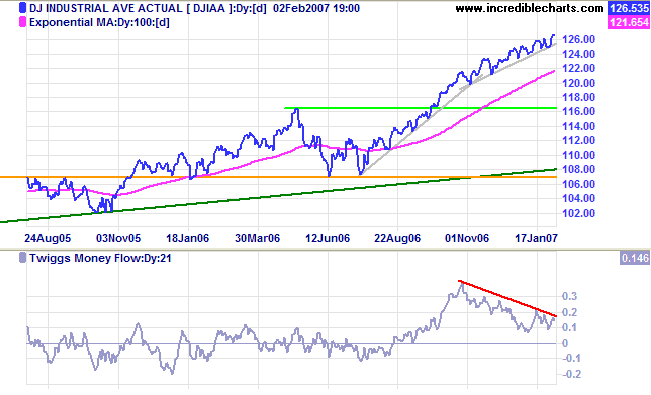
Short Term: The index completed a short double-bottom with a breakout above 12600 and is headed for the target of 12750: 12600 + (12600 - 12450). Short retracements of 1 or 2 days would be a further bullish sign.
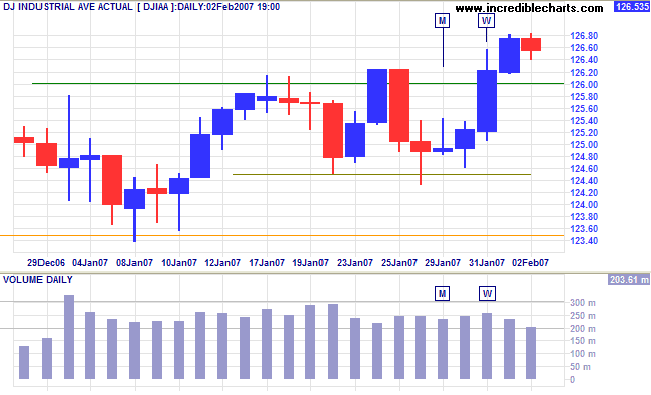
The Dow Jones Transportation Average completed a bullish
higher trough before breaking above the May 2006 high of 5000
to signal the start of a primary up-trend. This confirms the
existence of a
bull market. The Twiggs Money Flow trough above zero at [A]
signals strong accumulation.
Short Term: The only negative is Friday's weak close and
we should perhaps wait for a break above yesterday's high
before acting on the signal.
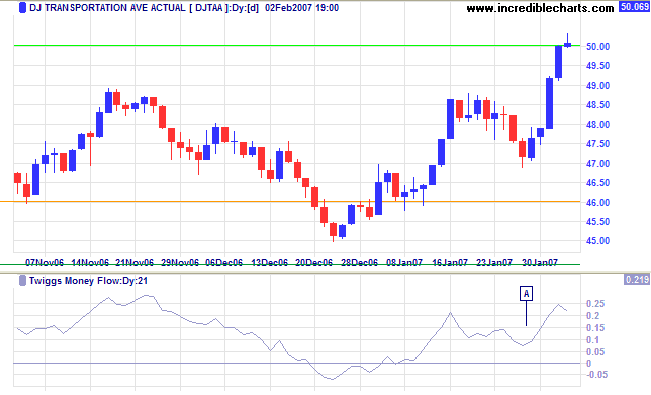
The Nasdaq Composite broke through resistance at 2470.
All we need to complete the bullish scenario is a break above
2500 (high of the previous marginal break) and completion of a
higher trough on
Twiggs Money Flow. TMF (21-day) has respected zero, but
continues to display a bearish
divergence.
Long Term: The index remains in a primary up-trend with
support at 2350/2370 (preceding high) and at 2000 (preceding
low).
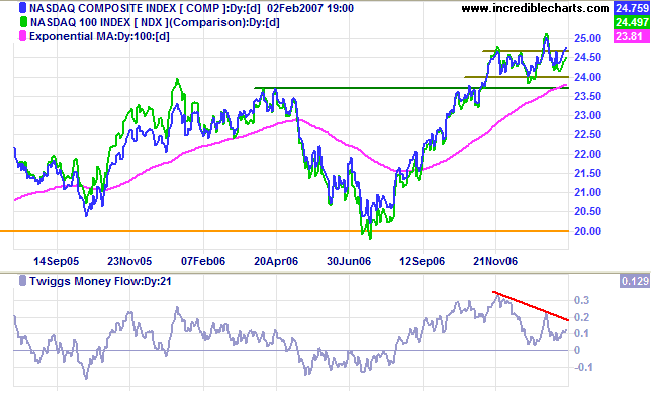
The S&P 500 shows an accelerating up-trend, with the index holding above the upper border of its 3-year trend channel (drawn at 2 standard deviations around a linear regression line). The index has surpassed its target of 1430 (1325+[1325-1220]) and we should not rule out a secondary correction (or large consolidation). Twiggs Money Flow (21-day), although displaying a large bearish divergence, has completed a bullish higher trough above zero at [A], signaling accumulation.
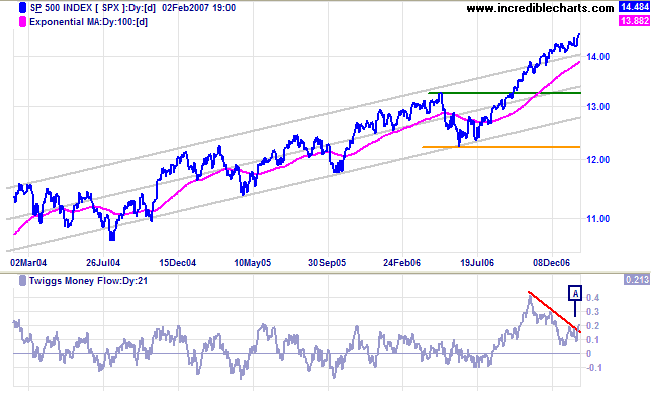
LSE: United Kingdom
The FTSE 100, is consolidating between 6160 and 6320; a
bullish position, above the new support line at 6100. A fall
below 6160, however, would warn of a secondary correction --
confirmed if the index breaks below 6000.
Twiggs Money Flow (21-day) is whipsawing around zero, as
you would expect during a consolidation when buyers and sellers
are evenly matched, but we need to be wary of the large bearish
divergence.
Long Term: The primary up-trend continues, with support
at 6000/6100 (preceding high) and at 5500 (preceding low).
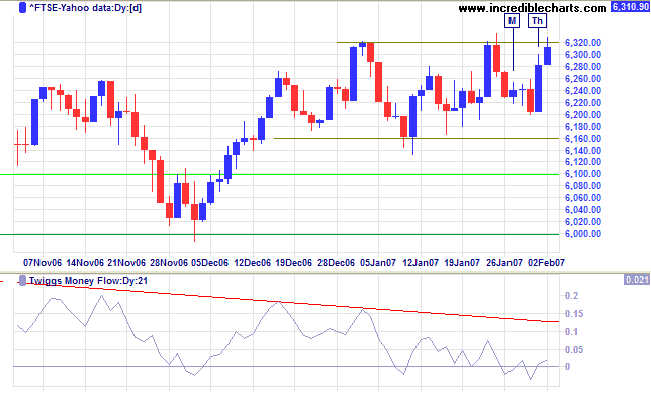
Nikkei: Japan
The Nikkei 225 displays a strong bull signal, with a
narrow consolidation [N] below resistance at the April high of
17600.
Twiggs Money Flow (21-day) troughs above the zero line (at
p1 and p2) signal strong accumulation. Expect a
breakout above 17600.
The target for the breakout is the next major resistance level
of 21000: 17600 + (17600 - 14200).
Long Term: The primary up-trend continues, with support
at 14200 (preceding low) and resistance at 17500/17600
(preceding high).
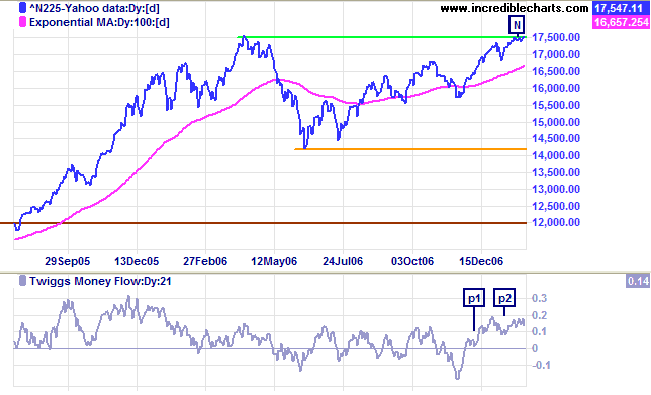
ASX: Australia
The All Ordinaries reached its target of 5800 [5300 +
(5300-4800)] and is approaching the upper border of the trend
channel (drawn at 2 standard deviations around a linear
regression line).
Twiggs Money Flow (21-day) is rising, but continues to
display a bearish divergence; TMF divergence signals are often
early, as in 2004/2005.
Long Term: The primary trend is up, with support at 5300
(the preceding high) and 4800 (preceding low).
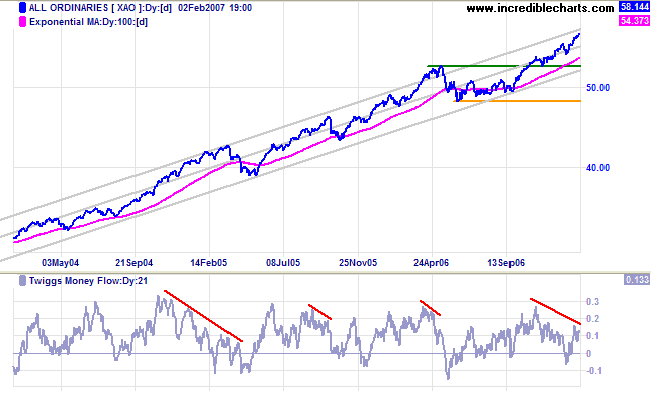
Short Term: Short retracements on Monday and Wednesday
signal buyer enthusiasm, with no sign of a reversal despite
this being the third leg of the latest upswing (Sep06 to
Feb07), and having reached the short-term target of 5800 [5650
+ (5650 - 5500)].
Reversal below 5740 would warn of a retracement.
Medium Term: A fall below the first line of support at
5650 would indicate that upward momentum is slowing, while a
break below support at 5480 would warn of a secondary
correction.
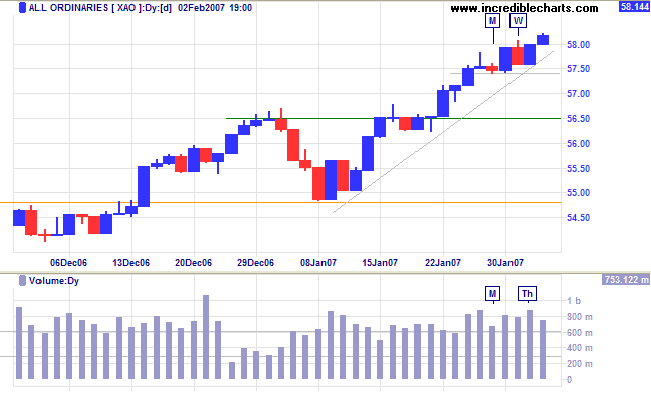
Kindness is more important than wisdom,
and the recognition of this is the beginning of wisdom.
~ Theodore Isaac Rubin
|
Technical Analysis and Predictions I believe that Technical Analysis should not be used to make predictions because we never know the outcome of a particular pattern or series of events with 100 per cent certainty. The best that we can hope to achieve is a probability of around 80 per cent for any particular outcome: something unexpected will occur at least one in five times. My approach is to assign probabilities to each possible outcome. Assigning actual percentages would imply a degree of precision which, most of the time, is unachievable. Terms used are more general: "this is a strong signal"; "this is likely"; "expect this to follow"; "this is less likely to occur"; "this is unlikely"; and so on. Bear in mind that there are times, especially when the market is in equilibrium, when we may face several scenarios with fairly even probabilities. Analysis is also separated into three time frames: short, medium and long-term. While one time frame may be clear, another could be uncertain. Obviously, we have the greatest chance of success when all three time frames are clear. The market is a dynamic system. I often compare trading to a military operation, not because of its' oppositional nature, but because of the complexity, the continual uncertainty created by conflicting intelligence and the element of chance that can disrupt even the best made plans. Prepare thoroughly, but allow for the unexpected. The formula is simple: trade when probabilities are in your favor; apply proper risk (money) management; and you will succeed. For further background, please read About The Trading Diary. |

Author: Colin Twiggs is a former investment banker with almost 40 years of experience in financial markets. He co-founded Incredible Charts and writes the popular Trading Diary and Patient Investor newsletters.
Using a top-down approach, Colin identifies key macro trends in the global economy before evaluating selected opportunities using a combination of fundamental and technical analysis.
Focusing on interest rates and financial market liquidity as primary drivers of the economic cycle, he warned of the 2008/2009 and 2020 bear markets well ahead of actual events.
He founded PVT Capital (AFSL No. 546090) in May 2023, which offers investment strategy and advice to wholesale clients.
